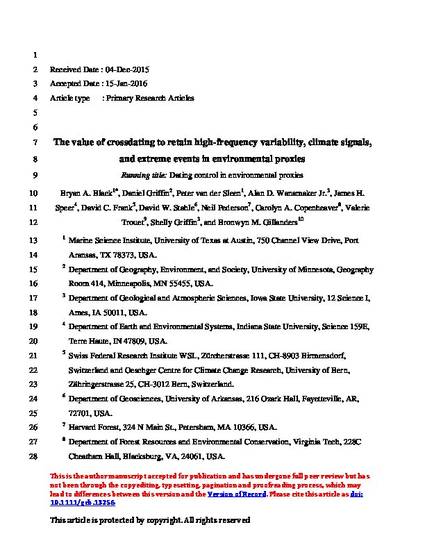
High-resolution biogenic and geologic proxies in which one increment or layer is formed per year are crucial to describing natural ranges of environmental variability in Earth’s physical and biological systems. However, dating controls are necessary to ensure temporal precision and accuracy; simple counts cannot ensure that all layers are placed correctly in time. Originally developed for tree-ring data, crossdating is the only such procedure that ensures all increments have been assigned the correct calendar year of formation. Here, we use growth-increment data from two tree species, two marine bivalve species, and a marine fish species to illustrate sensitivity of environmental signals to modest dating error rates. When falsely added or missed increments are induced at one and five percent rates, errors propagate back through time and eliminate high-frequency variability, climate signals, and evidence of extreme events while incorrectly dating and distorting major disturbances or other low-frequency processes. Our consecutive Monte Carlo experiments show that inaccuracies begin to accumulate in as little as two decades and can remove all but decadal-scale processes after as little as two centuries. Real-world scenarios may have even greater consequence in the absence of crossdating. Given this sensitivity to signal loss, the fundamental tenets of crossdating must be applied to fully resolve environmental signals, a point we underscore as the frontiers of growth-increment analysis continue to expand into tropical, freshwater, and marine environments.
Available at: http://works.bepress.com/alan-wanamaker/27/

This is the peer reviewed version of the following article: Black, Bryan A., Daniel Griffin, Peter van der Sleen, Alan D. Wanamaker Jr, James H. Speer, David C. Frank, David W. Stahle et al. "The value of crossdating to retain high‐frequency variability, climate signals, and extreme events in environmental proxies." Global Change Biology 22, no. 7 (2016): 2582-2595, which has been published in final form at doi: 10.1111/gcb.13256. This article may be used for non-commercial purposes in accordance with Wiley Terms and Conditions for Use of Self-Archived Versions.